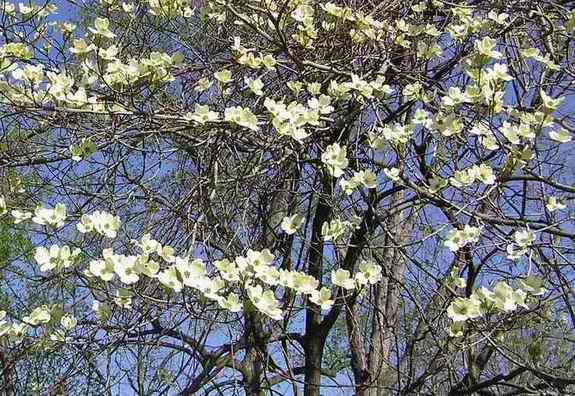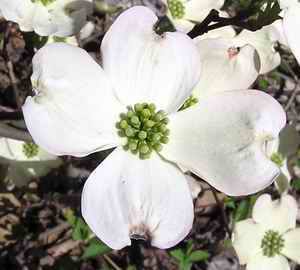|
Common Name: Flowering Dogwood, Dogberry tree, Hounds tree, Hounds berry Scientific Name: Cornus florida (Corneus is the Latin word for horn-like or made of horn and refers to the way that the dogwood grows from a forked trunk close to the ground that is "like horns." Florida is Latin for flowery or blossoming.)
The etymology of the name dogwood is subject to conjecture. An 1831 reference in "The Hardy Trees and Shrubs of Britain" attributed the name to the practice of bathing dogs in a decoction made from the bark of the tree as a curative agent for mange, a skin disease caused by parasitic mites. However, more recent research has failed to confirm this practice. It is more probable that the name is a corruption of the Middle English word dagge which means a hanging, pointed end (from which the name of the weapon dagger derives). The wood of the dogwood tree is exceptionally hard and it is therefore likely that it was whittled into dags. Thus the name dogwood is an adaptation of dagwood, as the latter term has fallen into desuetude.
The hard and dense wood of the dogwood tree is highly resistant to cracking, even under conditions of high loading and continuous use. Early in the industrial age, when textile mills were among the major industries of New England, dogwood was used to make weaving shuttles. It is estimated that 90 percent of the harvested dogwood in the 19th century were employed in this fashion. The ability to absorb energy and not deform made the wood ideally suited for chisel handles, wood golf club heads, and artificial teeth. Dogwood branches were stripped of their bark and used for chewing sticks to clean the teeth; the ends were rubbed against the teeth to make them white. It was reported that caries was very low in those who used dogwood chewing sticks. The beauty of the dogwood blossom has long been of especial note due to its early arrival in the spring and due to its striking appearance. What are perceived to be the petals of the flower are actually colored leaves called bracts that surround a central cluster of tiny yellow flowers. The reason the dogwood is so early is that the blossoms that emerge in the spring developed the previous summer, having wintered inside the bract. The term Dogwood Winter is used in some regions to refer to a period of cold weather often accompanied by frost that follows a mid-spring warm period, as it generally occurs in May when the dogwoods are blooming. It is the antithesis of Indian Summer.
Christian and Native American legends give testimony to the cultural impact of the dogwood. It was purportedly used by the Romans to make the cross on which Jesus was crucified as it was then said to be a tall and strong oak-like tree. The dogwood was ashamed of its role and begged forgiveness of Jesus, who transformed it with slender and gnarled branches that could never again be made into a cross. So that this would not be forgotten, he made the dogwood flower into a cross with blood-red stained nail prints at the edges with a crown of thorns in the middle. In Native American folk lore, a powerful chief demanded rich gifts from suitors for his four daughters. The gods were angry with his greedy behavior and turned him into a small tree with low branches that would never grow tall. His four daughters are still attendant in the four petals of the bract-flower.
Native Americans had many uses for the dogwood, both practical and medicinal. They made arrow shafts and daggers from the tough wood, used the blossoming of the dogwood tree as a sign to plant corn, and produced a bitter, antipyretic (fever reducing) drink from the bark. The medicinal uses of the dogwood were thus imparted to the early pioneers as a treatment for fevers. During the Civil War, access to ports was curtailed so that the bark of the Peruvian cinchona tree could not be imported for the quinine needed to treat malaria. Dogwood bark was used in its stead and found to be nearly as effective. The "King's American Pharmacy" of 1898 listed dogwood bark as "tonic, astringent, and slightly stimulant" for use with "periodical fevers, typhoid fevers, etc." and for "general exhaustion."
A disease named dogwood anthracnose that preferentially attacks dogwood trees was identified in the Seattle/Vancouver region in 1976 and in New York City area between 1978 and 1983. Research has revealed that the disease spread north and south along both coasts from these two initial sites. Though its origins are not known with precision, it is surmised that it was brought to this country on diseased trees that came in through the two ports. In 1991 the pathogen was fully identified as a fungus named Discula destructiva. Initial symptoms consist of leafspot, blotch and blight that appear on the leaves in the spring when they first open. The infection spreads from the leaves to the twigs causing twig death primarily in the lower branches (the disease was formerly called "lower branch dieback"). Trees in moist, shaded areas where the fungus thrives are the most susceptible. |

